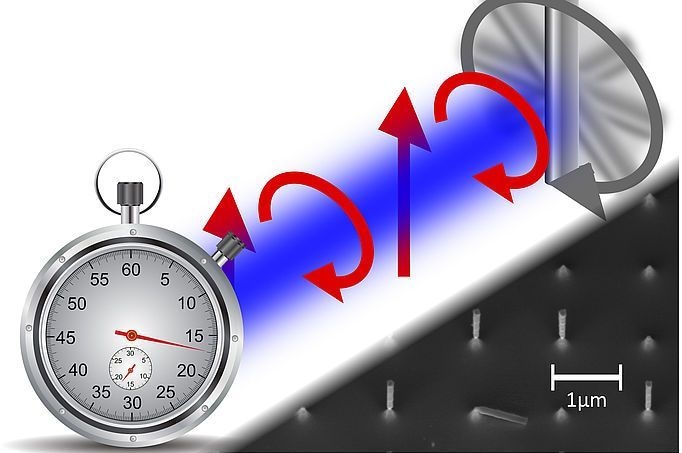Nov 22 2017
An international team from the Universities of Vienna, Tel Aviv and Duisburg-Essen has developed a nanomechanical hand to show the time of an electronic clock, by spinning a tiny cylinder using light.
Using focused laser beams, a silicon nanorod, which is less than a thousandth of a millimeter long, can be trapped in thin air. This nanorod is spun to follow the ticking of a clock, losing just one-millionth of a second over four days. This work will be published in the Nature Communications journal.
 An international team of researches from the Universities of Vienna, Duisburg-Essen and Tel Aviv use tiny silicon nano-cylinders as the ultra-stable hands of a clock. Using a laser to levitate the tiny rod, they make the nano-hands tick with pulses of polarized light (James Millen/University of Vienna).
An international team of researches from the Universities of Vienna, Duisburg-Essen and Tel Aviv use tiny silicon nano-cylinders as the ultra-stable hands of a clock. Using a laser to levitate the tiny rod, they make the nano-hands tick with pulses of polarized light (James Millen/University of Vienna).
Tick… tock…precise clocks are crucial in people’s daily lives. They allow them to navigate, from GPS to the marine chronometers used to determine longitude. Stable clocks power the internet and define the speed with which information can be received and sent.
If the clock is extremely precise, it is easy to notice even minor changes to its regularity. People can detect disturbances, such as vibrations of the case, by measuring the motion of a physical object which is keeping time, such as the pendulum of a grandfather clock, and comparing it to an electronic reference.
In the research published in "Nature Communications", Stefan Kuhn from the University of Vienna and his collaborators have created an impressively stable, material hand for an electronic clock, achieved by the rotations of a micrometer sized silicon cylinder, which is levitated by light. The team uses the clock to kick the tiny rotor with polarized light pulses, causing it to spin one million times a second.
It is amazing that we can take an electronic signal, and use it to perfectly drive the motion of a physical object, without any loss of stability. Our clock only lost one-millionth of a second over four days."
James Millen, Co-author
Similar tiny mechanical devices are limited in precision due to contact with their environment, but when levitated, the nano-rotor remains extremely stable for very long periods of time.
Preparing these nanomechanical devices depends on the art of making flawless silicon pillars on a chip, as done in the team of Fernando Patolsky at Tel Aviv University. The team at Vienna employs a "laser hammer" to knock out individual rods and traps them in tweezers made up of light.
Describing the resulting dynamics is a theoretical challenge that has been solved by the theoretical physicists Klaus Hornberger and Benjamin Stickler at the University of Duisburg-Essen. The spinning nano-rod has a chaotic motion – a behavior found in weather patterns and road traffic as well. It is possible to find islands of calm in the chaos, where the ticking of the nano-hands of the clock become ultra-stable, though this may not sound promising for technological application.
The ticking of a material, rather than electronic, clock is extremely sensitive to its environment. This very accurate, tiny hand of a watch can be employed to precisely measure properties of the world on the nanoscale, for example, pressure variations over sub-millimeter distances. The levitated cylinder could be moved through a beam of light or atoms to discern its properties, or through a gas flow to measure turbulence. Someday, it may even be possible to use this technique to test the limits of quantum physics: "At high rotation rates, this is an environmental sensor of stunning precision. At low frequencies it can open a new range of experiments on the quantum mechanics of rotation", said Markus Arndt.